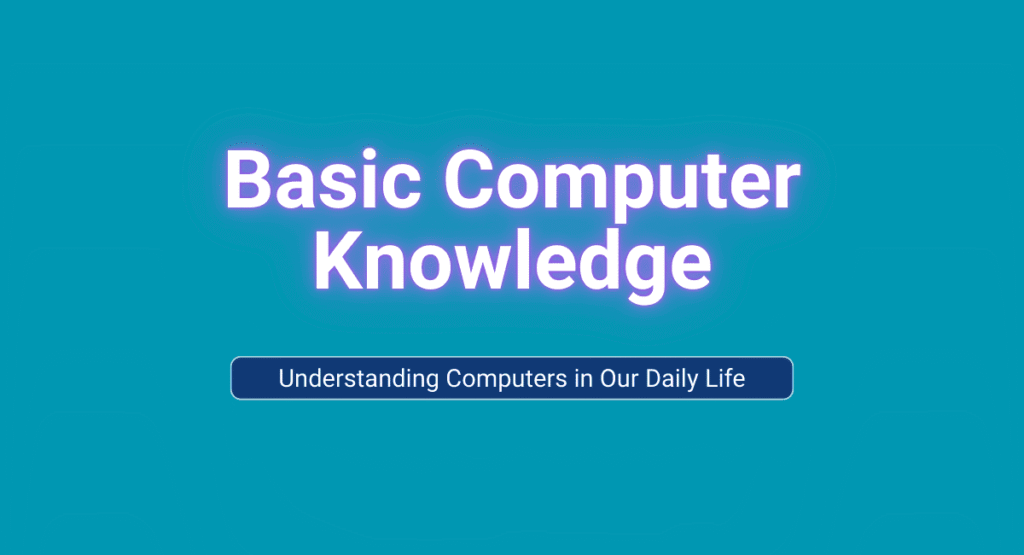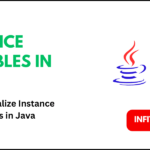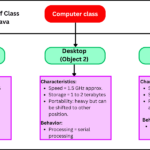In the digital age today, basic computer knowledge is no longer optional. It’s a fundamental skill that is required for education, jobs, communication, and even daily life activities. Whether you are a student, a working professional, or someone exploring technology for the first time, understanding the basics of computers gives you an edge in the modern world.
In this tutorial, we will get in-depth basic computer knowledge. We will understand the components, types, and functions of a computer. So, let’s start with what a computer is.
What is a Computer?
A computer is an electronic device or machine that processes data and converts it into meaningful information. It accepts input, processes it using a set of instructions (programs), stores the data, and provides output.
Definition:
A computer is a programmable electronic machine designed to carry out a sequence of operations (processing data) automatically. It does this by
- Accepting input
- Processing it according to a set of instructions (programs)
- Storing the data
- And converting it into meaningful output information.
Thus, the primary function of any computer is to take input, process it, and produce output. This is known as the Input-Process-Output (IPO) cycle.
Table of Contents
Real-life Example:
You can use a computer to type documents, send emails, browse the internet, handle spreadsheets, presentations, play games, and much more. When you type a message on your smartphone and hit “send,” the computer (i.e. phone’s processor) converts your text into digital signals and delivers it to the recipient.

History of Computers
Computers have evolved through generations, from mechanical devices to modern AI-powered machines. A closer look at the generations of computers is as:
1. First Generation (1940s – 1950s):
- Technology: Vacuum Tubes
- Characteristics: Enormous size (often room-sized), incredibly power-hungry, generated a vast amount of heat, unreliable, and slow speed by today’s standards.
- Key Example: ENIAC (Electronic Numerical Integrator and Computer) was the first general-purpose electronic computer. It weighed over 27 tons and used about 18,000 vacuum tubes.
- Other Examples: UNIVAC I was the first commercial computer delivered to a business client.
2. Second Generation (1950s – 1960s)
- Technology: Transistors
- Characteristics:
- Transistors replaced vacuum tubes, leading to a massive improvement in computer design.
- They were smaller, faster, more reliable, more energy-efficient, and generated less amount of heat than vacuum tubes.
- This advancement made computers more compact, affordable, and accessible for universities, research institutions, and large corporations.
- Key Example:
- The IBM 1401, introduced in 1959, was one of the most popular business computers of this era.
- It became widely used in accounting, payroll, and administrative applications.
- Major Development: This era saw the development of the first high-level programming languages, such as:
- FORTRAN (Formula Translation) – for scientific and engineering applications.
- COBOL (Common Business-Oriented Language) – for business and commercial applications.
- These languages made programming more accessible compared to machine and assembly language, which allow more industries to adopt computers.
3. Third Generation (1960s – 1970s)
- Technology: Integrated Circuits (ICs)
- Third-generation computers used Integrated Circuits (ICs), also called chips, which packed hundreds of transistors onto a single silicon chip.
- Characteristics:
- Much smaller in size compared to second-generation computers.
- Cheaper and more accessible for medium-sized businesses and universities.
- Faster processing speeds and improved reliability.
- Lower power consumption and heat generation.
- Better efficiency, making them suitable for broader applications.
- Key Example:
- The IBM System/360 series (1964) was a landmark family of mainframe computers.
- It was the first to use the same instruction set architecture (ISA) across an entire line of computers.
- This allowed organizations to upgrade systems without rewriting their software.
- Became extremely popular in the business, government, and scientific fields.
- Major Development:
- The development and widespread use of Operating Systems (OS) became common.
- For the first time, computers could run multiple programs at once (multiprogramming).
- Popular operating systems like IBM’s OS/360 introduced advanced resource management.
- High-level programming languages like BASIC and Pascal were also introduced during this era, further improving accessibility for education and programming.
4. Fourth Generation (1970s – 1990s)
- Technology: Microprocessors
- The most important feature of the fourth generation computers was the microprocessor—a single chip containing the entire Central Processing Unit (CPU).
- Introduced by Intel in 1971 (Intel 4004), microprocessors revolutionized computing by combining thousands (later millions) of transistors into one chip.
- Characteristics:
- Marked the true computer revolution.
- Enabled the creation of personal computers (PCs), making computing affordable and accessible to individuals and small businesses.
- Dramatically reduced size and cost while improving speed, efficiency, and reliability.
- Gave rise to computer networking and the foundations of the modern internet.
- Key Examples:
- Altair 8800 (1975): One of the first microcomputers available to hobbyists.
- Apple II (1977): Among the first successful mass-produced personal computers.
- IBM PC (1981): Standardized the personal computer market and became the model for PCs in homes and offices worldwide.
- Major Developments:
- Graphical User Interfaces (GUIs): Popularized by Apple Macintosh (1984) and later Microsoft Windows (1985). They made computers much easier for non-technical users through windows, icons, menus, and a mouse.
- Networking & the Internet: Early ARPANET (1969) evolved into the modern internet by the late 1980s and became widely available to the public in the early 1990s.
- Software Boom: Word processors, spreadsheets (like Lotus 1-2-3, later Microsoft Excel), and early games made PCs indispensable.
5. Fifth Generation (1990s – Present)
- Technology: AI, ULSI, Quantum Computing, Parallel Processing
- Based on ULSI (Ultra Large-Scale Integration), packing millions to billions of transistors on a single chip.
- Incorporates Artificial Intelligence (AI), Machine Learning (ML), and Parallel Processing for high performance.
- Ongoing research in Quantum Computing aims to solve problems beyond the reach of classical computers.
- Characteristics:
- Focus shifted from raw processing power to intelligence, connectivity, and usability.
- Ability to process natural language, recognize speech/images, learn, and make decisions.
- Rise of mobility and portability (smartphones, tablets, laptops).
- Dominance of cloud computing and big data—information is processed and stored in vast data centers accessible worldwide.
- Strong emphasis on networked computing, i.e., the World Wide Web (WWW), social media, and Internet of Things (IoT).
- Key Examples:
- AI Assistants: Siri (Apple), Alexa (Amazon), Google Assistant, and ChatGPT (OpenAI).
- Connectivity: The World Wide Web (1991) revolutionized communication, commerce, and knowledge sharing. Services like Google Drive, YouTube, Netflix, and Zoom showcase the era of cloud computing and streaming.
- Mobility: Smartphones (iPhone, Android) and tablets made computing personal, portable, and always connected.
- Emerging Tech:
- Quantum Computers from IBM, Google, and others, capable of solving highly complex problems.
- Self-driving cars, robotics, and advanced AI applications highlight the real-world impact of fifth-generation computing.
Types of Computers
Computers come in various shapes and sizes, each designed for specific purposes. We can categorize them based on their size, processing power, and use-case.
1. Supercomputers
- Description:
- Supercomputers are the most powerful and fastest computers in the world. They consist of thousands to millions of processors working in parallel to perform tasks at extremely high speeds. Their performance is measured in FLOPS (Floating Point Operations Per Second), often reaching exascale levels (10¹⁸ FLOPS).
- Function / Uses:
- Supercomputers handle tasks that require enormous computing power, far beyond ordinary computers.
- Weather Forecasting & Climate Modeling – predicting storms, hurricanes, and long-term climate change.
- Scientific Simulations – astronomy, molecular modeling, physics experiments.
- Nuclear Energy Research – simulating nuclear reactions and safety testing.
- Artificial Intelligence & Machine Learning – training large AI models.
- Medical Research – drug discovery, genome analysis, pandemic modeling.
- Supercomputers handle tasks that require enormous computing power, far beyond ordinary computers.
- Examples:
- Frontier (USA, 2022–Present): Currently the world’s fastest supercomputer, achieving exascale performance.
- Fugaku (Japan, 2020): Known for medical and climate research.
- Summit (USA): Previously the fastest, used for AI and scientific discovery.
- Sunway TaihuLight (China): Focused on advanced simulations and AI.
2. Mainframe Computers
- Description:
- Mainframe computers are large, powerful, and highly reliable systems designed to handle huge amounts of data and support hundreds or even thousands of users simultaneously. Unlike supercomputers (focused on speed and complex scientific tasks), mainframes are built for data processing, storage, and transaction handling at scale.
- Functions / Uses:
- Massive Data Processing – census records, government databases, and large-scale statistical analysis.
- Transaction Processing – millions of financial or retail transactions every second.
- Enterprise Applications – running mission-critical applications for large organizations.
- Virtualization & Multi-user Support – can run many virtual machines, serving thousands of concurrent users.
- Examples of Use Cases:
- Banking & Finance: Managing ATM transactions, online banking, and customer accounts.
- Insurance Companies: Processing policies, claims, and customer data.
- Government Agencies: Census data processing, tax records, and social security systems.
- Airlines: Ticket reservations, scheduling, and real-time passenger management.
- Notable Example Systems:
- IBM zSeries (z15, z16): Industry-leading mainframes used worldwide for enterprise computing.
- Unisys ClearPath systems: Known for secure, scalable enterprise applications.
3. Personal Computers (PCs)
- Description:
- Personal computers are designed for individual use.
- Unlike mainframes or supercomputers that serve multiple users simultaneously, a PC is intended for one person at a time, making them suitable for personal, educational, and business tasks.
- Types of Personal Computers:
- Desktop Computers
- Fixed at a single location (home, office, school).
- Typically more powerful, customizable, and easier to upgrade than laptops.
- Commonly used for gaming, software development, graphic design, and office work.
- Example: Dell OptiPlex, HP Pavilion.
- Laptop Computers (Notebooks)
- Portable, battery-powered devices with integrated screen, keyboard, trackpad, and speakers.
- Ideal for students, professionals, and travelers.
- Range from ultrabooks (lightweight) to gaming laptops (powerful hardware).
- Example: Apple MacBook, Lenovo ThinkPad.
- Tablets
- Highly portable, touchscreen-based devices.
- Use a virtual keyboard instead of a physical one.
- Often used for reading, web browsing, note-taking, and entertainment.
- Example: Apple iPad, Samsung Galaxy Tab.
- Smartphones
- Primarily designed for communication (calls, messages, internet).
- Modern smartphones are powerful enough to be considered pocket-sized computers.
- Can run complex applications, play games, support video conferencing, and more.
- Example: iPhone, Samsung Galaxy, Google Pixel.
Basic Components of a Computer
A computer system consists of hardware and software components.
a) Hardware
- CPU (Central Processing Unit) – Brain of the computer.
- RAM (Random Access Memory) – Temporary memory.
- Hard Disk / SSD – Permanent storage.
- Motherboard – Connects all parts.
- Power Supply Unit (PSU) – Provides electricity.
b) Peripherals
- Keyboard, Mouse (Input devices)
- Monitor, Printer (Output devices)
- Example: When you play a video game, the CPU processes graphics, RAM stores temporary data, and GPU (Graphics Processing Unit) handles visuals.
Input and Output Devices
Input Devices: Used to give commands to the computer.
- Keyboard
- Mouse
- Scanner
- Microphone
- Touchscreen
Output Devices: Show results of processing.
- Monitor
- Printer
- Speakers
- Projector
Software and Hardware
Hardware: Physical parts of a computer. (CPU, keyboard, monitor).
Software: Set of programs that tell the hardware what to do.
There are three types of software:
- System Software (Operating System like Windows, Linux, macOS).
- Application Software (MS Word, Excel, Chrome, WhatsApp).
- Utility Software (Antivirus, Disk Cleanup tools).
Example: When you open MS Word, you use application software running on an OS.
Operating Systems (OS)
An Operating System is software that manages hardware, software, and resources of a computer. Some popular operating systems are as:
- Windows 11
- macOS
- Linux
- Android
- iOS
Example: When you click on an icon, the OS interprets your command and displays the result.



Excellent article. Thanks for sharing better knowledge.